Scaffolding Companies Lansdowne
Top 10 Scaffolding Contractors in Lansdowne
Get 3 FREE Scaffolding Companies quotes for your project today! Compare profiles, reviews, accreditations, portfolio, etc... and choose the best offer.

Dynamic Hoisting & Scaffolding
54 reviews43-30 48th St, Long Island City, 11104, USAt Dynamic Hoisting & Scaffolding, we transform your vision into reality with our expertise in hoisting and scaffolding solutions. Our team is dedicated to delivering exceptional results, ensuring your projects are completed on time and within budget. Established in 2013, Dynamic Hoisting & Scaffolding is dedicated to providing high-quality construction services that exceed our clients' expectations. Our mission is to innovate, sustain, and continually improve every aspect of our work. Join us in transforming the construction landscape with our reliable scaffolding solutions. We use the highest quality materials and craftsmanship to ensure durability and excellence in every project. We conduct our business with transparency, honesty, and respect, prioritize the safety of our employees, clients, and the community, and embrace new technologies and methods to enhance efficiency and effectiveness.
- Services
- Why Us?
- Testimonials
- Gallery
Get Quote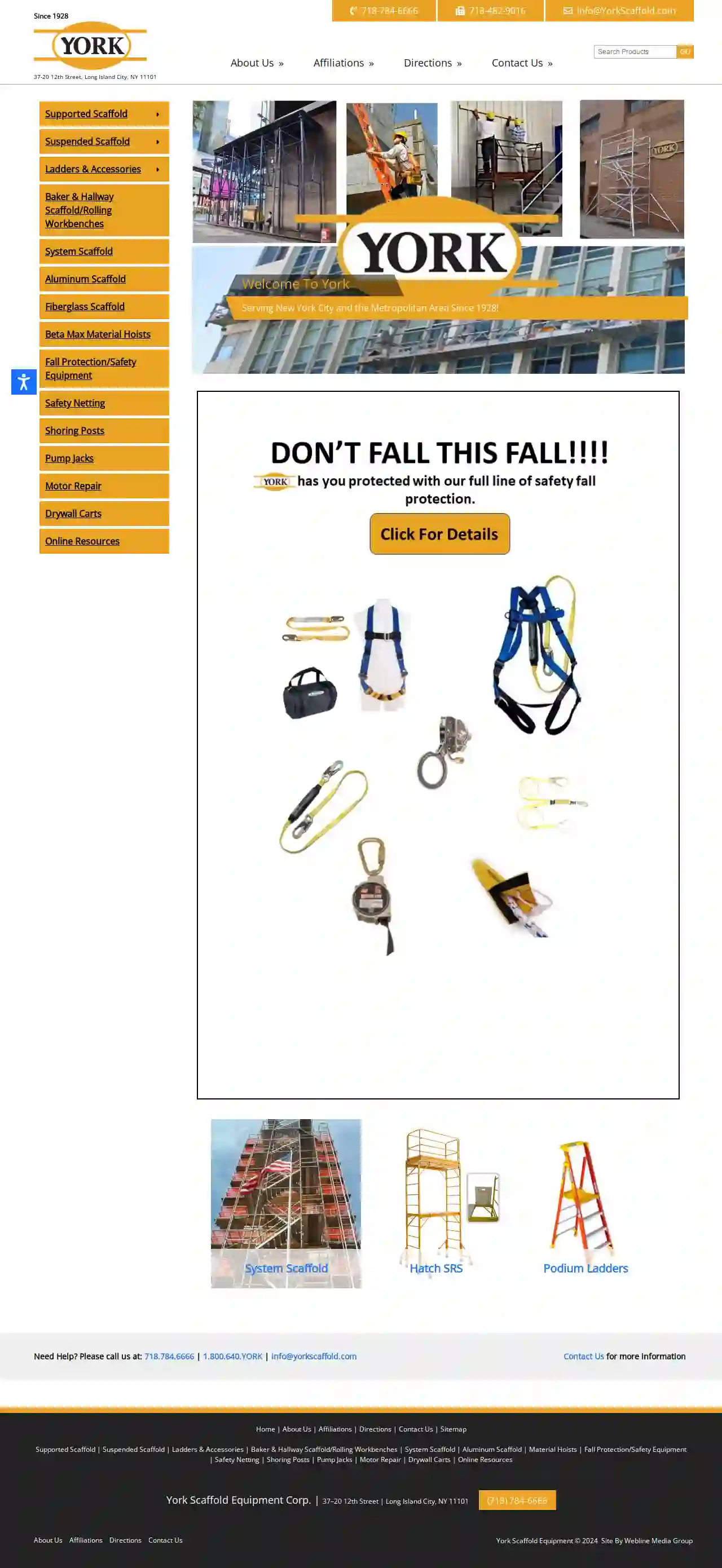
York Equipment Corp.
4.628 reviewsLong Island City, NY, 37-20 12th Street, 11101, USYork Scaffold Equipment Corp. has been serving New York City and the Metropolitan Area since 1928. The company specializes in providing a wide range of scaffolding solutions, including supported, suspended, and system scaffolds, as well as ladders, accessories, and safety equipment. With a strong commitment to customer satisfaction and safety, York Scaffold Equipment Corp. offers top-quality products and services to meet the needs of construction and renovation projects.
- Services
- Why Us?
- Accreditations
- Our Team
- Testimonials
- Gallery
Get Quote
West New York Restoration of CT, INC
4.512 reviews1800 Boston Rd, Bronx, 10460, USWest New York Restoration of CT, Inc was founded in 1984 by Principal Alfred Gallicchio with the goal of providing high-quality contracting services in the field of exterior restoration, roofing and waterproofing. The philosophy of the company and its owner is a simple and direct one: to combine experience, management services, and skilled workforce to achieve the highest level of quality for each project. West New York Restoration of CT, Inc.'s key personnel bring a wealth of experience to each project. Whether the problem at hand concerns roofing, waterproofing, masonry, or structural repair, West New York Restoration of CT, Inc. can provide the solution.
- Services
- Why Us?
- Our Team
- Gallery
Get Quote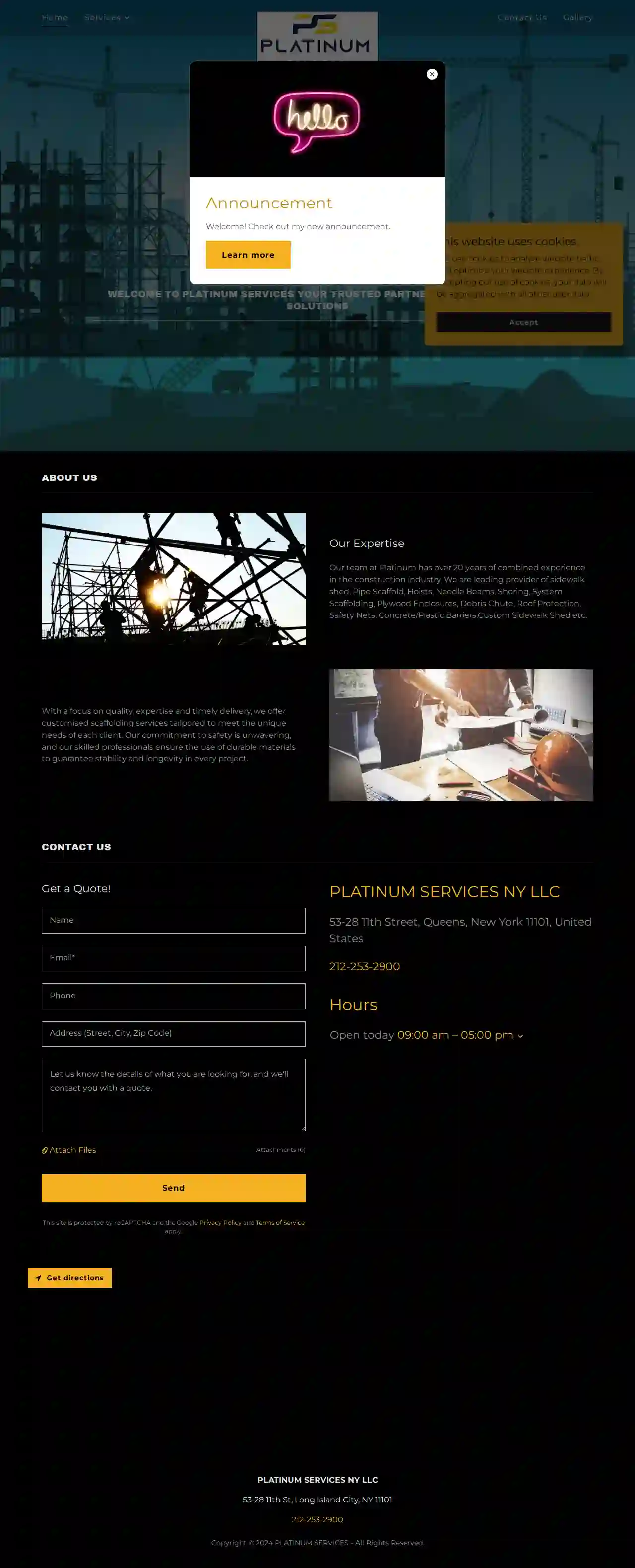
Platinum Services
34 reviews53-28 11th St, Long Island City, 11101, USWelcome to Platinum Services, your trusted partner in scaffolding solutions. With over 20 years of combined experience in the construction industry, our team at Platinum has the expertise to provide customized scaffolding services tailored to meet the unique needs of each client. Our commitment to safety is unwavering, and our skilled professionals ensure the use of durable materials to guarantee stability and longevity in every project. We offer a range of services, including sidewalk shed, Pipe Scaffold, Hoists, Needle Beams, Shoring, System Scaffolding, Plywood Enclosures, Debris Chute, Roof Protection, Safety Nets, Concrete/Plastic Barriers, and Custom Sidewalk Shed. Contact us today to get a quote and learn more about our services.
- Services
- Why Us?
- Gallery
Get Quote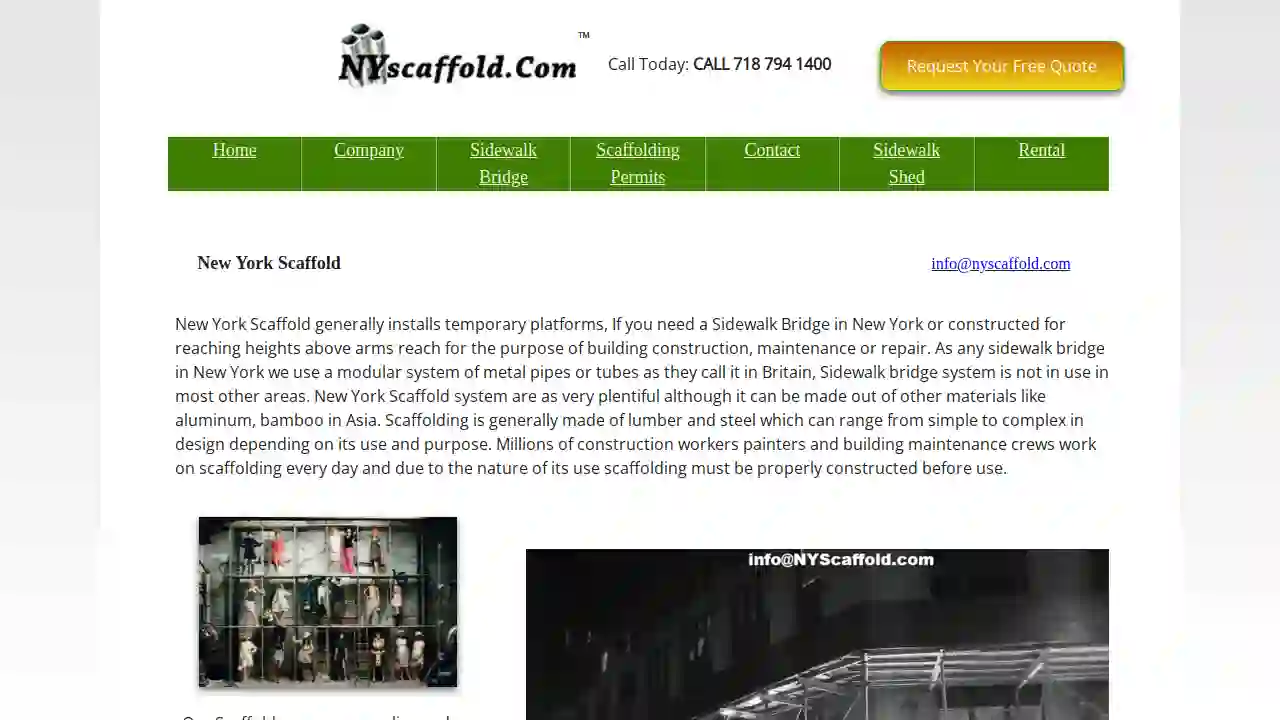
NY Scaffolding
York, USNY Scaffold is a leading national scaffold contractor and scaffolding erection company. We specialize in providing a range of access services for both commercial and residential projects throughout the US. We are fully focused on customer satisfaction and pride ourselves on the range of services we provide. We have a 95% repeat business rate, a testament to our commitment to quality and reliability. NY Scaffold is fully self-sufficient and one of the largest stockholders of the sidewalk bridge system in the US. This forms the basis of our motto: safety, speed, and efficiency. Our business is built on providing high-quality scaffolding and sidewalk bridge solutions, ensuring the safety and productivity of our clients' projects. We offer a comprehensive range of services, including: Scaffolding Erection and Dismantling Sidewalk Bridge Installation and Removal Scaffolding Permits Shoring Hoisting Construction Fencing Our team of experienced scaffold erectors is dedicated to providing safe, efficient, and reliable service. We utilize the latest equipment and techniques to ensure that all projects are completed to the highest standards. Whether you need scaffolding for a small residential project or a large commercial construction site, NY Scaffold has the expertise and resources to meet your needs. Contact us today for a free quote and let us help you take your project to new heights.
- Services
- Why Us?
- Gallery
Get Quote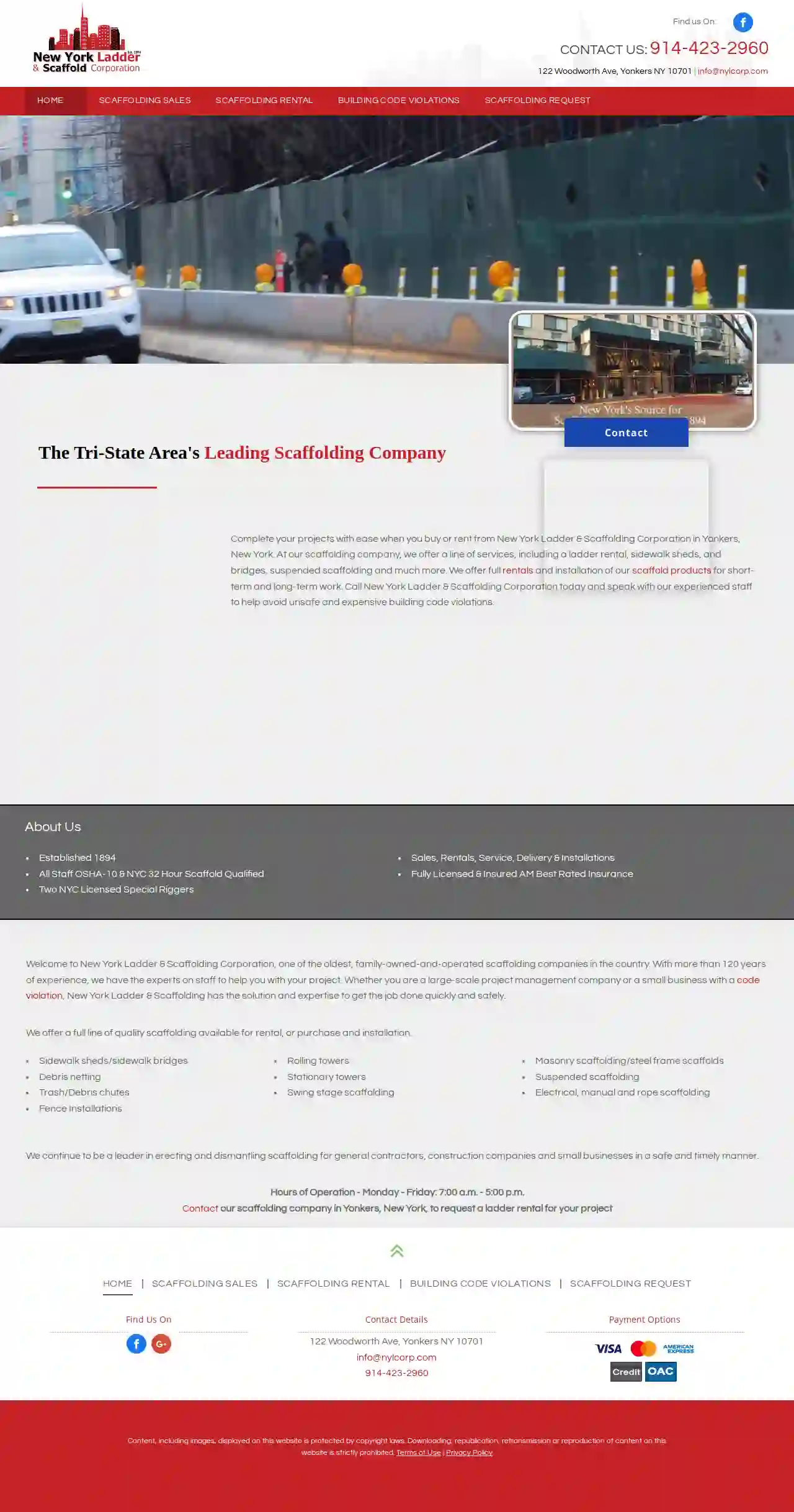
New York Ladder & Scaffold Corporation
46 reviews122 Woodworth Ave, Yonkers, 10701, USWelcome to New York Ladder & Scaffolding Corporation, one of the oldest, family-owned-and-operated scaffolding companies in the country. With more than 120 years of experience, we have the experts on staff to help you with your project. Whether you are a large-scale project management company or a small business with a code violation, New York Ladder & Scaffolding has the solution and expertise to get the job done quickly and safely. We offer a full line of quality scaffolding available for rental, or purchase and installation. Our services include sidewalk sheds/sidewalk bridges, debris netting, trash/debris chutes, fence installations, rolling towers, stationary towers, swing stage scaffolding, masonry scaffolding/steel frame scaffolds, suspended scaffolding, electrical, manual and rope scaffolding. We continue to be a leader in erecting and dismantling scaffolding for general contractors, construction companies and small businesses in a safe and timely manner. Our hours of operation are Monday - Friday: 7:00 a.m. - 5:00 p.m. Contact our scaffolding company in Yonkers, New York, to request a ladder rental for your project.
- Services
- Why Us?
- Accreditations
- Gallery
Get Quote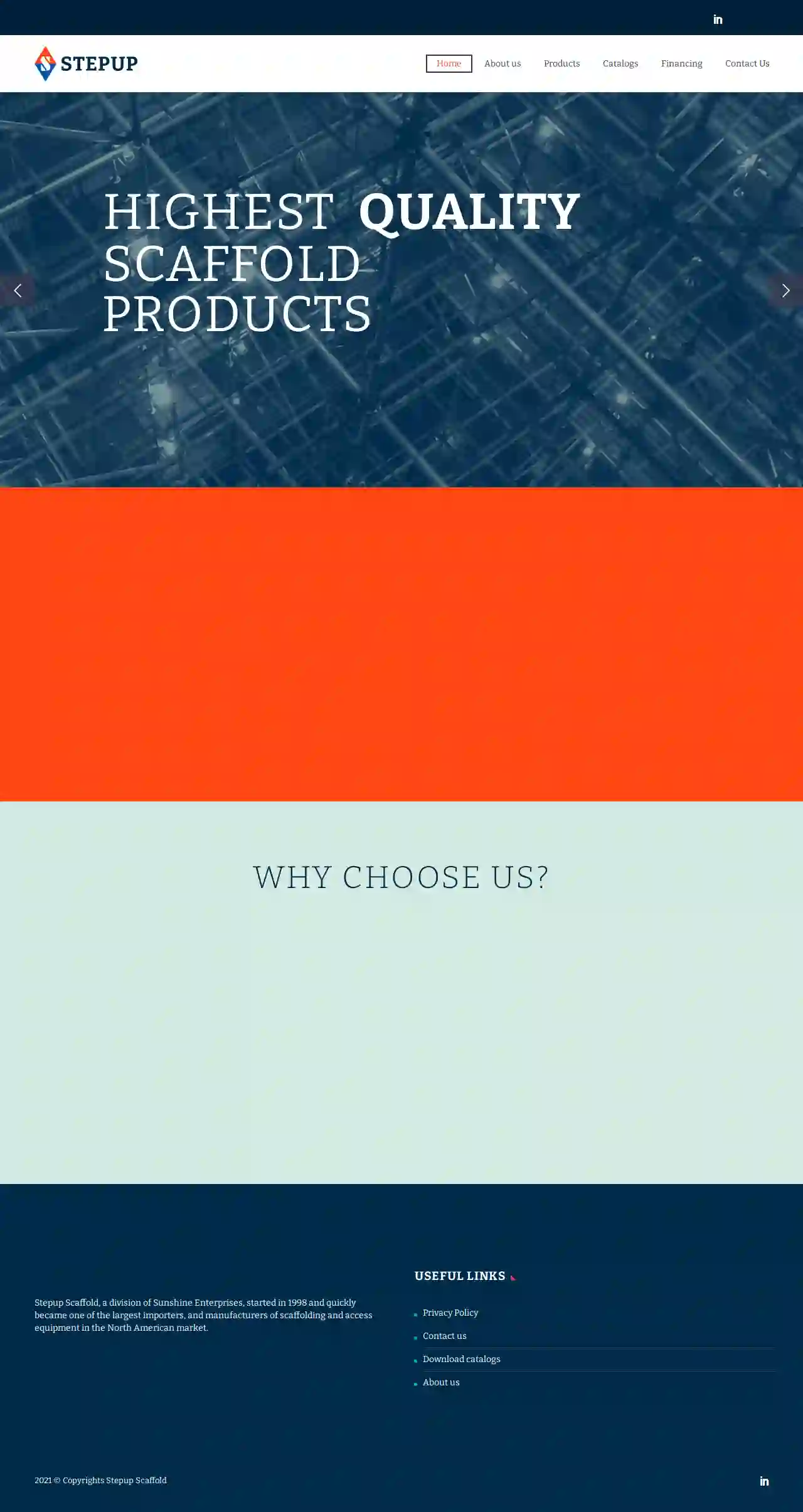
StepUp Scaffolding Warehouse - NY Branch
4.426 reviews1234 NW 12th St, Miami, 33122, USStepup Scaffold, a division of Sunshine Enterprises, started in 1998 and quickly became one of the largest importers and manufacturers of scaffolding and access equipment in the North American market. Our commitment to Quality, Service, and Satisfaction influences everything we do. We believe that a high tide raises all boats, so to raise everything and everyone, our statement of purpose, simply put is that “We elevate our employees, customers, and industries to safely move, build, and maintain the world.”
- Services
- Why Us?
- Accreditations
- Our Team
- Testimonials
- Gallery
Get Quote
NYC Sidewalk Shed & Pipe Scaffolding
51 reviews1078 Arnow Ave, Bronx, NY, USAbout NYC Sidewalk Shed & Pipe Scaffolding NYC Sidewalk Shed & Pipe Scaffolding is the most trusted provider of premium quality sidewalk sheds and pipe scaffolding in NYC. We are the leading pipe scaffolding and sidewalk erector company, providing services in the whole of NYC. As a result of 20+ years of experience in the industry, we have become adept in providing high-quality sidewalk sheds and pipe scaffoldings consistently earning the satisfaction of all our clients. Our Mission At NYC, our mission is to provide excellent sidewalk shed and scaffolding services at extremely affordable rates. Hence, providing quality and safety that’s within everyone’s’ reach. From modern equipment to the best professionals, we try to cater to you with the best in every aspect. We aim to completely redefine what is possible in the construction industry by setting new standards for safety, efficiency, and innovation. Why Choose Us Providing you with high-quality solutions for all your problems is our foremost concern. We work with skilled professionals that have years of experience in dealing with sidewalk sheds and pipe scaffoldings. Besides, we make sure to use the best quality material sourced from the best manufactures. Hence, ensuring you quality structures that can withstand the test of time. Duralbes and Safe Structures We design safe and reliable pipe scaffoldings and sidewalk structures that can easily support the desired load. These structures will be stable and robust ensuring safety for everyone. Moreover, we assure compliance with both local and international safety codes, ensuring the complete safety of pedestrians and site workers from all sorts of accidents.
- Services
- Why Us?
- Gallery
Get Quote
MG Rigging & Scaffolding Services
51 reviews48-11 69th Street, Woodside, 11377, USMG Rigging and Scaffolding Services is a one-stop shop for Suspended Access needs in NYC, NY, Long Island, and New Jersey. With hands-on rigging experience and extensive knowledge of products and regulations governing the scaffolding industry, our staff provides top-notch services. From Suspended Scaffolding Rental, Installation, and Sales to Special Rigger Services and Rigging Safety consulting, we've got you covered. Our team assists Engineers and Architects with Local Law 11 Facade Inspections and Repairs, and we offer Engineered Plans, CD5 Permits, DOL Permits, and Expediting. We're committed to providing exceptional service and ensuring your project is completed safely and efficiently.
- Services
- Why Us?
- Accreditations
- Gallery
Get Quote
Keystone Sidewalk Shed & Scaffolding NYC
526 reviewsNew York City, USAt Keystone Sidewalk Shed & Scaffolding, we are dedicated to providing top-quality sidewalk shed and scaffolding solutions in New York City. Our commitment to safety, efficiency, and excellence sets us apart from the rest. With over 20 years of experience, we have successfully handled numerous projects, ensuring the safety of workers and pedestrians alike. Our team consists of DOB and OSHA-certified experts who are renowned for erecting high-capacity structures that comply with OSHA regulations. We offer a wide range of services including scaffolding rental, sidewalk shed rental, Jersey barriers rental, temporary fencing rental, and rigging services. Our commitment to safety has earned us prestigious awards, making us the trusted choice for diverse project needs.
- Services
- Why Us?
- Accreditations
- Our Team
- Testimonials
- Gallery
Get Quote
Over 2,353+ Scaffolding Companies on our platform
Our scaffolding companies operate in Lansdowne & surroundings!
ScaffoldingHQ has curated and vetted Top Scaffolding Companies in Lansdowne. Find a top & trustworthy business today.
Frequently Asked Questions About Scaffolding Companies
- Online Directories: Use specialized directories like ScaffoldingHQ to search for scaffolding companies in your area.
- Search Engines: Use Google or other search engines to search for 'scaffolding companies near me' or 'scaffolding rental [your location]'.
- Local Construction Associations: Contact local construction associations for recommendations.
- Word-of-Mouth Referrals: Ask friends, family, or colleagues for recommendations based on their past experiences.
- Experience and Expertise: Look for companies with a proven track record in your type of project, whether it's residential, commercial, or industrial.
- Licensing and Insurance: Verify that the company has the necessary licenses and insurance coverage to operate legally and protect you from liability.
- Safety Record: Inquire about their safety practices and training programs for their employees. A strong safety culture is crucial in scaffolding.
- Reputation and Reviews: Check online reviews and testimonials from previous clients to gauge their reliability and quality of work.
- Professionalism: Choose a company that communicates clearly, provides detailed quotes, and demonstrates a commitment to customer satisfaction.
- Size and Complexity: Larger, more intricate scaffolding structures will naturally take longer to assemble.
- Scaffolding Type: System scaffolding, with its pre-engineered components, can be erected faster than traditional tube and clamp scaffolding.
- Accessibility: Difficult site access or limited working space can prolong the erection process.
- Crew Size and Experience: The number and skill level of the scaffolding erectors will impact the speed of assembly.
How can I find scaffolding companies near me?
How do I find a reputable scaffolding company?
How long does it take to erect scaffolding?
Can I erect scaffolding myself?
How can I find scaffolding companies near me?
- Online Directories: Use specialized directories like ScaffoldingHQ to search for scaffolding companies in your area.
- Search Engines: Use Google or other search engines to search for 'scaffolding companies near me' or 'scaffolding rental [your location]'.
- Local Construction Associations: Contact local construction associations for recommendations.
- Word-of-Mouth Referrals: Ask friends, family, or colleagues for recommendations based on their past experiences.
How do I find a reputable scaffolding company?
- Experience and Expertise: Look for companies with a proven track record in similar projects, whether it's residential, commercial, or industrial.
- Licensing and Insurance: Verify that the company has the necessary licenses and insurance coverage to operate legally and protect you from liability.
- Safety Record: Inquire about their safety practices and training programs for their employees. A strong safety culture is crucial in scaffolding.
- Reputation and Reviews: Check online reviews and testimonials from previous clients to gauge their reliability and quality of work.
- Professionalism: Choose a company that communicates clearly, provides detailed quotes, and demonstrates a commitment to customer satisfaction.
How long does it take to erect scaffolding?
- Size and Complexity: Larger, more intricate scaffolding structures will naturally take longer to assemble.
- Scaffolding Type: System scaffolding, with its pre-engineered components, can be erected faster than traditional tube and clamp scaffolding.
- Accessibility: Difficult site access or limited working space can prolong the erection process.
- Crew Size and Experience: The number and skill level of the scaffolding erectors will impact the speed of assembly.